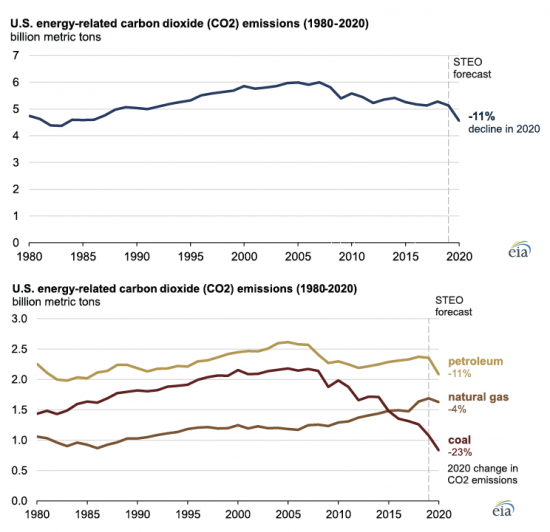All
COVID-19 Clears the Air

Carbon emissions expected to plummet in 2020
The U.S. Energy Information Administration (EIA) released a forecast projecting that U.S. energy-related carbon dioxide (CO2) emissions would fall by 11 percent in 2020. If realized, this decline would represent the largest in not only percentage but also absolute terms in EIA’s energy-related CO2 series, which dates all the way back to 1949. In EIA’s May Short-Term Energy Outlook, U.S. energy-related CO2 emissions were forecast to fall even more than the 5-percent decline in gross domestic product (GDP) in 2020.
Predictably, much of the drop in CO2 emissions in EIA’s updated forecast arises from estimates of the travel restrictions and general economic slowdown associated with the efforts to mitigate the spread of COVID-19. However, even before the effects of COVID-19 became apparent in mid-March, EIA had expected a decline in 2020 energy-related emissions, generally consistent with the trend of lower U.S. CO2 emissions since their peak in 2007.
In mid-March, U.S. demand for petroleum products began to decline. By mid-April, demand reached its lowest levels in decades. Stay-at-home orders, travel restrictions, and work-from-home arrangements reduced demand for motor gasoline, distillate fuel oil (primarily consumed as diesel), and jet fuel. Petroleum is the largest single source of energy-related CO2 emissions in the United States, accounting for 46 percent of the 2019 total. In EIA’s May short-term forecast, petroleum product consumption declines by 11 percent in 2020, and petroleum-related CO2 emissions decline by 12 percent.
Natural gas accounts for the second-largest share of energy-related U.S. CO2 emissions, at 33 percent of the 2019 total. Compared with petroleum and coal, EIA expects a relatively smaller decline in natural gas consumption and its related CO2 emissions (both 4 percent lower) in 2020. The electric power sector is the largest consumer of natural gas, and although EIA forecasts power sector electricity generation to decline by 5 percent, EIA expects natural gas consumed by the power sector to only decline by 1 percent because of relatively low natural gas prices. The closing or reduced operation of many nonessential businesses, combined with generally warmer weather in 2020, leads to a decline in commercial sector natural gas consumption.
U.S. energy-related emissions from coal have fallen in each of the past six years, and it accounted for 21 percent of the 2019 total. EIA’s latest forecast expects coal CO2 emissions to fall 23 percent in 2020 to 832 million metric tons, or less than half of its peak level in 2007. The electric power sector accounted for more than 90 percent of the coal consumed in the United States in 2019, and EIA expects coal to continue to lose market share to natural gas and renewables in the power sector in 2020.
At press time, (May 19), EIA forecasts that energy-related CO2 will increase in 2021 by 5 percent. This change in emissions is proportionally less than the expected change in the economy (6 percent increase in GDP) as businesses, industries, and institutions resume normal operation.
EIA isn’t the only group forecasting declines in CO2 emissions as a byproduct of COVID-19. A report by San Francisco-based think tank Energy Innovation projects that stay-at-home orders, shuttered manufacturing, reduced travel, and other impacts from the COVID-19 pandemic will reduce U.S. greenhouse gas emissions between 7 percent and 11 percent relative to 2019. Energy Innovation expects emissions to rebound by 2025. The reductions are “not likely to have a material impact on annual emissions in 2030 or cumulative emissions through 2050,” the report says.
Meanwhile, climate activists want to avoid a return to pre-pandemic emissions and have called for a “green recovery” that prioritizes carbon neutrality and environmental reforms as policymakers consider ways to stimulate and rebuild the economy.

Related Posts
 U.S. Competing to Secure Critical Minerals
U.S. Competing to Secure Critical Minerals
Posted on June 16, 2025
 The Clean Air Act, the EPA, and State Regulations
The Clean Air Act, the EPA, and State Regulations
Posted on May 14, 2025
 Day Tanks Support Back-up Generators in Extreme Conditions
Day Tanks Support Back-up Generators in Extreme Conditions
Posted on March 10, 2025
 Major Breakthrough in Lithium-Ion Batteries
Major Breakthrough in Lithium-Ion Batteries
Posted on February 12, 2025
Enter your email to receive important news and article updates.
